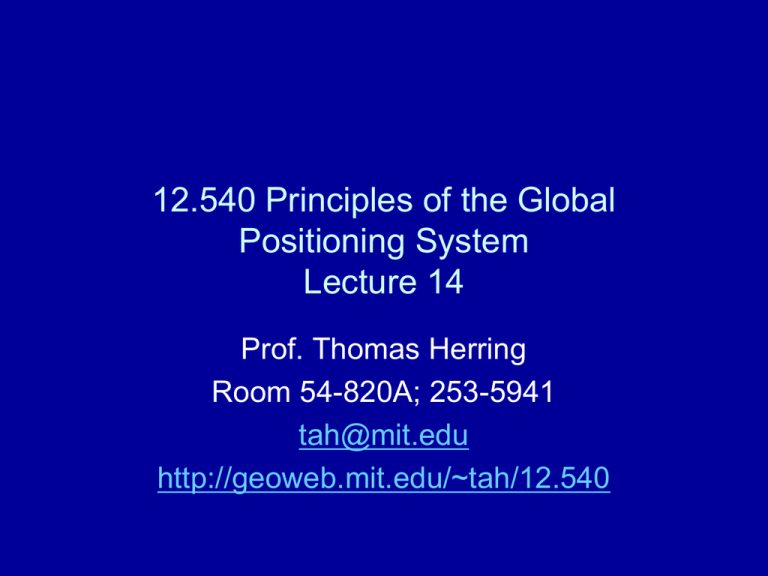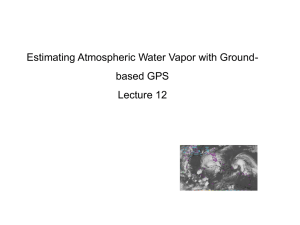PowerPoint Presentation - 12.540 Principles of the - GeoWeb
advertisement

12.540 Principles of the Global Positioning System Lecture 14 Prof. Thomas Herring Room 54-820A; 253-5941 tah@mit.edu http://geoweb.mit.edu/~tah/12.540 204/05/2010 Lec 14 Propagation Medium • Propagation: – Signal propagation from satellite to receiver – Light-time iteration – Basic atmospheric and ionospheric delays – Propagation near receiving antenna 304/05/2010 Lec 14 Propagation • Basics: – Signal, tagged with time from satellite clock, transmitted. – About 60 msec (20,000 km) later the signal arrives at GPS receiver. Satellite has moved about 66 m during the time it takes signal to propagate to receiver. – Time the signal is received is given by clock in receiver. Difference between transmit time and receive time is pseudorange. – During the propagation, signal passes through the ionosphere (10-100 m of delay, phase advance), and neutral atmosphere (2.3-30 m depending on elevation angle). 404/05/2010 Lec 14 Propagation • To determine an accurate position from range data, we need to account for all these propagation effects and time offsets. • In later lectures, examine ionospheric and atmospheric delays, and effects near antenna. • Basic clock treatment in GPS – True time of reception of signal needed – True time of transmission needed (af0, af1 from broadcast ephemeris initially OK) – Position of satellite when signal transmitted 504/05/2010 Lec 14 Times • RINEX data files, tag measurements by reception time as given by the receiver clock. The error in the receiver time must be determined iteratively • For linearized least squares or Kalman filter need to establish non-linear model and then estimator determines adjustments to parameters of model (e.g. receiver site coordinates) and initial clock error estimates that “best” match the data. 604/05/2010 Lec 14 Non-linear model • Basics of non-linear model: – Rinex data file time tags give approximate time measurement was made. – Using this time initially, position of satellite can be computed – Range computed from receiver and satellite position – Difference between observed pseudorange and computed ranges, gives effects of satellite and receiver clock errors. In point positioning, satellite clock error is assumed known and when removed from difference, error in receiver clock determined. – With new estimate of receiver clock, process can be iterated. – If receiver position poorly known, then whole system can be iterated with updated receiver coordinates. 704/05/2010 Lec 14 Sensitivities • Satellites move at about 1km/sec, therefore an error of 1 msec in time results in 1 m satellite position (and therefore in range estimate and receiver position). • For pseudo-range positioning, 1 msec errors OK. For phase positioning (1 mm), times needed to 1 msec. • (1 msec is about 300 m of range. Pseudorange accuracy of a few meters in fine). 804/05/2010 Lec 14 “Light-time-iteration” • To compute theoretical range; two basic methods used – (a) “Doppler shift corrections” ie. Account for rate of change of range during propagation time – (b) “Light-time-iteration” Method most commonly used. • Light time iteration: Basic process is to compute range using simple Cartesian geometry but with position of receiver at receive time and position of transmitter at transmit time. 904/05/2010 Lec 14 Light-time-iteration • Light time iteration must be computed in a nonrotating frame • Reason: Consider earth-fixed frame: one would simply compute Earth fixed coordinates at earlier time. In non-rotating frame, rotation to inertial coordinates would be done at two different time (receiver when signal received; transmitted when signal transmitted). • Difference is rotation of Earth on ~60 msec. Rotation rate ~460 m/sec; therefore difference is about 30 meters. 004/05/2010 Lec 14 Clock errors PRN 03 (June 14) 800 Clock SA (ns) 1999 Clock NoSA (ns) 2000 Clock error (ns) 600 400 200 0 -200 0 4 8 12 Time (hrs) 16 20 24 104/05/2010 Lec 14 Relativistic effects • General relativity affects GPS in three ways – Equations of motions of satellite – Rates at which clock run – Signal propagation • In our GPS analysis we account for the second two items • Orbits only integrated for 1-3 days and equation of motion term is considered small 204/05/2010 Lec 14 Clock effects • GPS is controlled by 10.23 MHz oscillators • On the Earth’s surface these oscillators are set to 10.23x(1-4.4647x10-10) MHz (39,000 ns/day rate difference) • This offset accounts for the change in potential and average velocity once the satellite is launched. • The first GPS satellites had a switch to turn this effect on. They were launched with “Newtonian” clocks 304/05/2010 Lec 14 Propagation and clock effects • Our theoretical delay calculations are made in an Earth centered, non-rotating frame using a “light-time” iteration i.e., the satellite position at transmit time is differenced from ground station position at receive time. • Two corrections are then applied to this calculation 404/05/2010 Lec 14 Corrections terms • Propagation path curvature due to Earth’s potential (a few centimeters) 2GM Rr Rs 3 ln c Rr Rs • Clock effects due to changing potential GM e a sin E 2 c • For e=0.02 effect is 47 ns (14 m) 504/05/2010 Lec 14 Effects of General Relativity PRN 03 Detrended; e=0.02 50 Clock - trend (ns) GR Ef fect (ns) Clock error (ns) 25 0 -25 -50 0 4 8 12 Time (hrs) 16 20 24 604/05/2010 Lec 14 Tests of General Relativity • After some back of the envelope derivations, in the parameterized post-Newtonian formulation, the time delay expression* becomes: 2 GM (2 g ) e a sin E 2 3 c • In PPN, g is the gravitational curvature term. In general relativity g = 1. It usually appears as (1+g)/2 but this has been modified as explained next. • The clock estimates from each GPS satellite allow daily estimates of g 704/05/2010 Lec 14 PPN formulation • • • The clock rate correction is made of two parts: – Special relativity term that depends on v2/2c2 where v is the satellite velocity and c is the speed of light. – General relativity contribution that depends on 2U/c2 where U is potential The periodic variations arise from the eccentricity of the orbit: At perigee – v is fastest which slows clock – U is largest which also slows clock (decreasing potential increases the clock rate). The contribution to from the special relativity term is half that of the general relativity term and thus the g formulation. 804/05/2010 Lec 14 Using GPS to determine g • • • • • Each day we can fit a linear trend and once-per-revolution sin and cos terms to the clock estimates of each of the 28-32 GPS satellites. Comparison between the amplitude and phase (relative to sin(E)) allows and estimate of gamma to be obtained Quadrature estimates allows error bound to be assessed (cos(E) term) Problems: - Once-per-orbit perturbations are common. However should not be proportional to eccentricity. - Also possible thermal effects on the clocks in the satellites. (This is probably largest effect as we will see). - General quality of clocks in the satellites. There are multiple groups that process global GPS data using different processing software and analysis methods (double differencing versus one-way clock estimation). 904/05/2010 Lec 14 Example satellite clock (PRN 07) Results from different analysis groups Eccentricity is 0.011; g ~25 ns. 004/05/2010 Lec 14 Differences between groups • RMS differences are about 0.2% of relativistic effect (measure of “processing” noise). • Clock variation is ~4%. • Eccentricity ~0.011: 25 ns 104/05/2010 Lec 14 PRN 28 MIT Analysis Error bars from RMS fit to clock estimates (linear, sinE and cosE terms only). Red line is fit to annual signal. 204/05/2010 Lec 14 PRN 28 GFZ analysis Results are similar but “annual” is slightly different 304/05/2010 Lec 14 Examples of receiver clock behavior • Examples of satellite and station clock behaviors can be found at: • http://geoweb.mit.edu/~tah/MITClk • IGS Time Standards are given at: https://goby.nrl.navy.mil/IGStime/index.php • Directories are by GPS week number and directories ending in W are total clock estimates; folders ending in D are differences between IGS analysis centers • Now examine some examples 404/05/2010 Lec 14 Receiver clocks: ASC1 150 ASC1_Clk_(m) 100 ASC1_Clk_(m) 50 0 -50 -100 -150 14.0 14.5 Day 15.0 15.5 504/05/2010 Lec 14 Receiver Clock: HOB2 Hydrogen Maser -1950 HOB2_clk_(m) -2000 HOB2_clk_(m) -2050 -2100 -2150 -2200 -2250 14.0 14.5 Day 15.0 15.5 604/05/2010 Lec 14 ASC/HOB2 Linear trends removed 20 15 ASC1 detrended (m) HOB2 detrended (m) Detrended (m) 10 5 0 -5 -10 -15 -20 14.0 14.5 Day 15.0 15.5 704/05/2010 Lec 14 HOB2 only 1.0 HOB2 detrended (m) Detrended (m) 0.5 0.0 -0.5 -1.0 14.0 14.5 Day 15.0 15.5 804/05/2010 Lec 14 Summary of clocks • In some cases; clock are well enough behaved that linear polynomials can be used. • Most commonly: receiver clocks are estimated at every measurement epoch (white noise clocks) or GPS data is differenced to remove clock (as in question 2 of HW 2). • Errors in receiver clocks are often thousands of km of equivalent time. • More detailed analysis of gamma estimates in following slides. 904/05/2010 Lec 14 Analysis of result • Not all satellites look like PRN 28. Only a few satellites are so well behaved. • The following figures show some examples that show: – Change in character when satellite changed (PRN02) – Effects of change from Cs to Rb clocks (PRN10) – Effects of changing eccentricity of orbit (PRN18) - change from 0.001 to 0.010 – Period of oscillation: Draconic period: Period of orbital plane relative to sun (precession of node makes this different from 365.25 days). Since all satellites in ~55 deg inclination and precess at the same rate, period is 351.4 days. 004/05/2010 Lec 14 Change of satellite 104/05/2010 Lec 14 Change of clock type from Cs to Rb Change from Cs to Rb 204/05/2010 Lec 14 Effects of increasing eccentricity 304/05/2010 Lec 14 Annual versus Draconic Period






